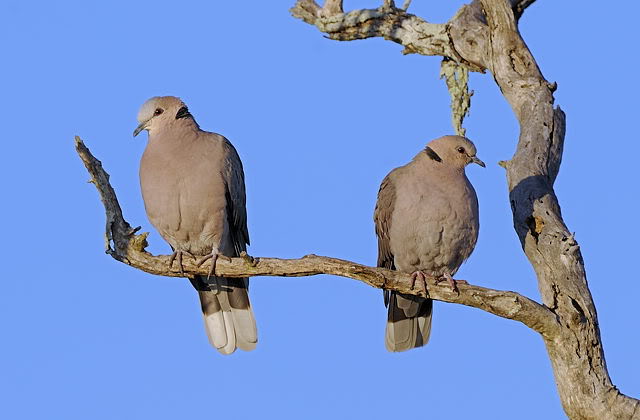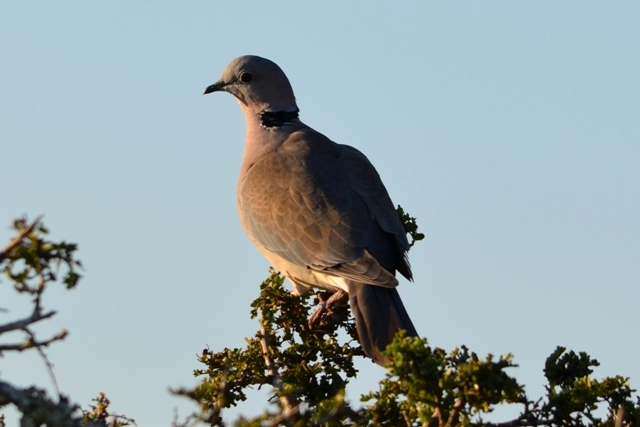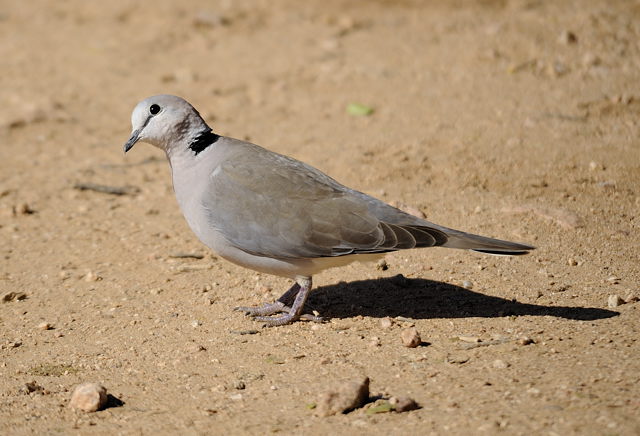African Mourning Dove, Mourning Collared Dove
Posted: Mon Mar 10, 2014 8:10 am
353. African Mourning Dove, Mourning Collared Dove Streptopelia decipiens (Rooioogtortelduif)
Order: Columbiformes. Family: Columbidae
Description
Size 28-30 cm. Its back, wings and tail are pale brown. The head is grey and the underparts are pink, shading to pale grey on the belly. Black flight feathers, white in tail. One of the 'ring-necked doves', with a conspicuous black collar, clearly fringed with white along its upper edge, on the back of its neck. It has a patch of bare skin around the eye are red. The bill is blackish; the legs and feet pink. Males and females are similar.
The juvenile is browner than the adults, and have wing coverts tipped buff.
Similar species: Smaller, paler grey than the larger Red-eved Dove, which is much larger, is overall very much darker and has a deep red (not pale) eye. When flying, it shows blackish flight feathers and extensive white in the tail, the latter being a distinction from the Red-eyed Dove. It may be distinguished from the similar Cape Turtle Dove by the red skin around yellow eyes and the totally grey head.
Distribution
It occurs in sub-Saharan Africa, excluding the lowland forest of West Africa and the DRC. In southern Africa it is locally common in northern Namibia, northern Botswana, southern and northern Zimbabwe, Mozambique and north-eastern South Africa. Particularly common at Satara and Letaba camps in the Kruger National Park.
The African Mourning Dove has a localized distribution, with two apparently separate populations: a southern one in the lowveld of the eastern and northern Transvaal, the Limpopo Valley and adjacent lowlands, Zimbabwe and Botswana, extending eastwards into Mozambique; and a northern one extending from the Zambezi Valley in northern Zimbabwe, westwards through the Caprivi and at scattered localities across northern Namibia, southwards into the Okavango and along the upper Boteti River.
Habitat
Thornveld, riverine forest, cultivated areas and gardens in bushveld. It generally prefers moist lowland savanna, riverine Acacia woodland and cultivated areas surrounding villages. It can also be found in patches of Ana-trees (Faidherbia albida) on flood plains of the Zambezi river.
Diet
Mainly eats seeds, supplemented with insects and fruit. It typically forages on the ground, in flocks of up to about 30 birds.
Breeding
Mourning Doves are monogamous. The female builds the nest with material collected by the male, consisting of a 15 cm wide bowl, made with twigs, leaves and roots, and typically placed in forks in trees 1.5-15.0 m above ground. It lays 1-2 white eggs, which are incubated for about 13-14 days. The chicks stay in the nest for 15-18 days.
Call
A soft, dove-like call can often be heard at night, a loud krroooo, okrroooo or coo, coo.
Status
Locally common resident.
Order: Columbiformes. Family: Columbidae
Description
Size 28-30 cm. Its back, wings and tail are pale brown. The head is grey and the underparts are pink, shading to pale grey on the belly. Black flight feathers, white in tail. One of the 'ring-necked doves', with a conspicuous black collar, clearly fringed with white along its upper edge, on the back of its neck. It has a patch of bare skin around the eye are red. The bill is blackish; the legs and feet pink. Males and females are similar.
The juvenile is browner than the adults, and have wing coverts tipped buff.
Similar species: Smaller, paler grey than the larger Red-eved Dove, which is much larger, is overall very much darker and has a deep red (not pale) eye. When flying, it shows blackish flight feathers and extensive white in the tail, the latter being a distinction from the Red-eyed Dove. It may be distinguished from the similar Cape Turtle Dove by the red skin around yellow eyes and the totally grey head.
Distribution
It occurs in sub-Saharan Africa, excluding the lowland forest of West Africa and the DRC. In southern Africa it is locally common in northern Namibia, northern Botswana, southern and northern Zimbabwe, Mozambique and north-eastern South Africa. Particularly common at Satara and Letaba camps in the Kruger National Park.
The African Mourning Dove has a localized distribution, with two apparently separate populations: a southern one in the lowveld of the eastern and northern Transvaal, the Limpopo Valley and adjacent lowlands, Zimbabwe and Botswana, extending eastwards into Mozambique; and a northern one extending from the Zambezi Valley in northern Zimbabwe, westwards through the Caprivi and at scattered localities across northern Namibia, southwards into the Okavango and along the upper Boteti River.
Habitat
Thornveld, riverine forest, cultivated areas and gardens in bushveld. It generally prefers moist lowland savanna, riverine Acacia woodland and cultivated areas surrounding villages. It can also be found in patches of Ana-trees (Faidherbia albida) on flood plains of the Zambezi river.
Diet
Mainly eats seeds, supplemented with insects and fruit. It typically forages on the ground, in flocks of up to about 30 birds.
Breeding
Mourning Doves are monogamous. The female builds the nest with material collected by the male, consisting of a 15 cm wide bowl, made with twigs, leaves and roots, and typically placed in forks in trees 1.5-15.0 m above ground. It lays 1-2 white eggs, which are incubated for about 13-14 days. The chicks stay in the nest for 15-18 days.
Call
A soft, dove-like call can often be heard at night, a loud krroooo, okrroooo or coo, coo.
Status
Locally common resident.


 © pooky
© pooky © Dewi
© Dewi © Flutterby
© Flutterby © Flutterby
© Flutterby © Dewi
© Dewi © steamtrainfan
© steamtrainfan
 © Mel
© Mel © Dewi
© Dewi © BluTuna
© BluTuna © Kesheshe
© Kesheshe

 © Sharifa
© Sharifa © ExFmem
© ExFmem © Bushcraft
© Bushcraft © Flutterby
© Flutterby © Toko
© Toko